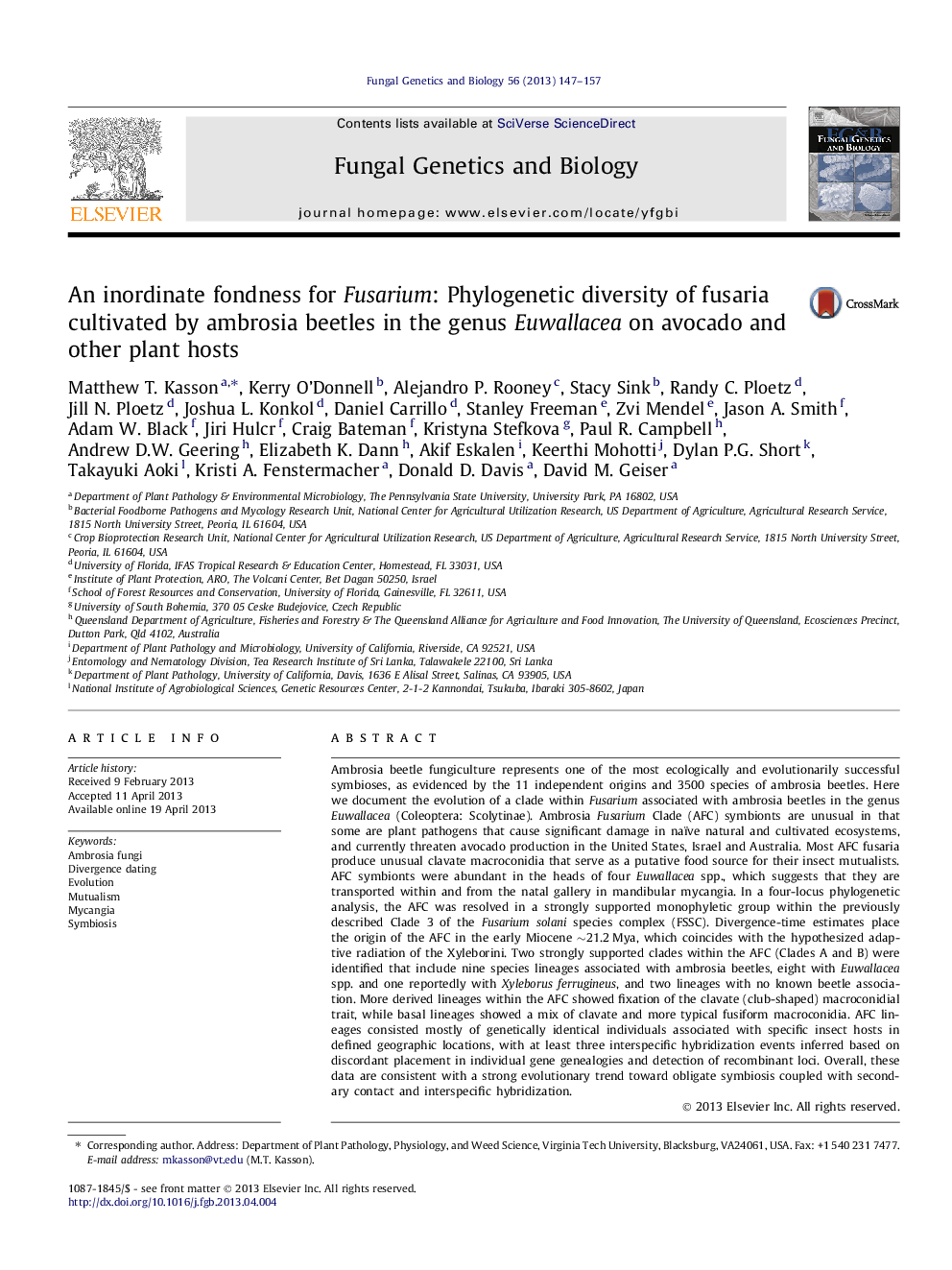| کد مقاله | کد نشریه | سال انتشار | مقاله انگلیسی | نسخه تمام متن |
|---|---|---|---|---|
| 8471002 | 1550034 | 2013 | 11 صفحه PDF | دانلود رایگان |
عنوان انگلیسی مقاله ISI
An inordinate fondness for Fusarium: Phylogenetic diversity of fusaria cultivated by ambrosia beetles in the genus Euwallacea on avocado and other plant hosts
دانلود مقاله + سفارش ترجمه
دانلود مقاله ISI انگلیسی
رایگان برای ایرانیان
کلمات کلیدی
موضوعات مرتبط
علوم زیستی و بیوفناوری
بیوشیمی، ژنتیک و زیست شناسی مولکولی
بیولوژی سلول
پیش نمایش صفحه اول مقاله

چکیده انگلیسی
Ambrosia beetle fungiculture represents one of the most ecologically and evolutionarily successful symbioses, as evidenced by the 11 independent origins and 3500 species of ambrosia beetles. Here we document the evolution of a clade within Fusarium associated with ambrosia beetles in the genus Euwallacea (Coleoptera: Scolytinae). Ambrosia Fusarium Clade (AFC) symbionts are unusual in that some are plant pathogens that cause significant damage in naïve natural and cultivated ecosystems, and currently threaten avocado production in the United States, Israel and Australia. Most AFC fusaria produce unusual clavate macroconidia that serve as a putative food source for their insect mutualists. AFC symbionts were abundant in the heads of four Euwallacea spp., which suggests that they are transported within and from the natal gallery in mandibular mycangia. In a four-locus phylogenetic analysis, the AFC was resolved in a strongly supported monophyletic group within the previously described Clade 3 of the Fusarium solani species complex (FSSC). Divergence-time estimates place the origin of the AFC in the early Miocene â¼21.2Â Mya, which coincides with the hypothesized adaptive radiation of the Xyleborini. Two strongly supported clades within the AFC (Clades A and B) were identified that include nine species lineages associated with ambrosia beetles, eight with Euwallacea spp. and one reportedly with Xyleborus ferrugineus, and two lineages with no known beetle association. More derived lineages within the AFC showed fixation of the clavate (club-shaped) macroconidial trait, while basal lineages showed a mix of clavate and more typical fusiform macroconidia. AFC lineages consisted mostly of genetically identical individuals associated with specific insect hosts in defined geographic locations, with at least three interspecific hybridization events inferred based on discordant placement in individual gene genealogies and detection of recombinant loci. Overall, these data are consistent with a strong evolutionary trend toward obligate symbiosis coupled with secondary contact and interspecific hybridization.
ناشر
Database: Elsevier - ScienceDirect (ساینس دایرکت)
Journal: Fungal Genetics and Biology - Volume 56, July 2013, Pages 147-157
Journal: Fungal Genetics and Biology - Volume 56, July 2013, Pages 147-157
نویسندگان
Matthew T. Kasson, Kerry O'Donnell, Alejandro P. Rooney, Stacy Sink, Randy C. Ploetz, Jill N. Ploetz, Joshua L. Konkol, Daniel Carrillo, Stanley Freeman, Zvi Mendel, Jason A. Smith, Adam W. Black, Jiri Hulcr, Craig Bateman, Kristyna Stefkova,